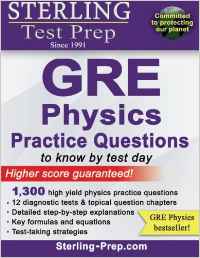|
#2
1st April 2016, 02:06 PM
| |||
| |||
| Re: Physics GRE Practice Test
As you want here I am telling Physics GRE Practice test consists of approximately 100 five-choice questions, some of which are grouped in sets and based on such materials as diagrams, graphs, experimental data and descriptions of physical situations. Here I am suggest some good book Sterling Test Prep GRE Physics Practice Questions Paperback – Import, 14 Jun 2015 by Sterling Test Prep (Corporate Author)  Conquering the Physics GRE Paperback – 18 Sep 2012 by Yoni Kahn (Author), Adam Anderson (Author)  Physics GRE Practice Test material CLASSICAL MECHANICS — 20% (such as kinematics, Newton's laws, work and energy, oscillatory motion, rotational motion about a fixed axis, dynamics of systems of particles, central forces and celestial mechanics, three-dimensional particle dynamics, Lagrangian and Hamiltonian formalism, noninertial reference frames, elementary topics in fluid dynamics) ELECTROMAGNETISM — 18% (such as electrostatics, currents and DC circuits, magnetic fields in free space, Lorentz force, induction, Maxwell's equations and their applications, electromagnetic waves, AC circuits, magnetic and electric fields in matter) OPTICS AND WAVE PHENOMENA — 9% (such as wave properties, superposition, interference, diffraction, geometrical optics, polarization, Doppler effect) THERMODYNAMICS AND STATISTICAL MECHANICS — 10% (such as the laws of thermodynamics, thermodynamic processes, equations of state, ideal gases, kinetic theory, ensembles, statistical concepts and calculation of thermodynamic quantities, thermal expansion and heat transfer) QUANTUM MECHANICS — 12% (such as fundamental concepts, solutions of the Schrödinger equation (including square wells, harmonic oscillators, and hydrogenic atoms), spin, angular momentum, wave function symmetry, elementary perturbation theory) ATOMIC PHYSICS — 10% (such as properties of electrons, Bohr model, energy quantization, atomic structure, atomic spectra, selection rules, black-body radiation, x-rays, atoms in electric and magnetic fields) SPECIAL RELATIVITY — 6% (such as introductory concepts, time dilation, length contraction, simultaneity, energy and momentum, four-vectors and Lorentz transformation, velocity addition) LABORATORY METHODS — 6% (such as data and error analysis, electronics, instrumentation, radiation detection, counting statistics, interaction of charged particles with matter, lasers and optical interferometers, dimensional analysis, fundamental applications of probability and statistics) SPECIALIZED TOPICS — 9% Nuclear and Particle physics (e.g., nuclear properties, radioactive decay, fission and fusion, reactions, fundamental properties of elementary particles), Condensed Matter (e.g., crystal structure, x-ray diffraction, thermal properties, electron theory of metals, semiconductors, superconductors), Miscellaneous (e.g., astrophysics, mathematical methods, computer applications) |